From the heart of industry comes the beating drum of precision, the artistry of engineering captured in one place: the horizontal milling machine. These vital cogs in the machinery of manufacturing often go unnoticed, but their contributions are immense.
Horizontal milling machines are, at their core, mechanical devices engineered to shape solid materials like metal and wood. Armed with a rotating cutting tool, these machines craft intricate parts and components that find their way into a multitude of products we use daily. They take on an interesting approach to material removal, applying cutting force along a horizontal axis, which differentiates them from their vertical counterparts.
Despite their unassuming exterior, these powerhouses of precision are critical to industries far and wide. From the automotive sector to aerospace, and from furniture to intricate electronics, their versatility and efficiency keep the wheels of production turning. In fact, their role in shaping our industrial landscape is as unmistakable as it is undeniable.
This exploration takes us deeper into the world of horizontal milling machines, uncovering their mechanics, capabilities, and impact on modern industry. As we delve into the whirring, buzzing intricacies of these machines, let's not forget the magnitude of their silent, dutiful contribution to the world around us. We invite you to join us on this journey of discovery, through the sounds and sparks of the workshop, and into the heart of manufacturing itself.
To truly appreciate the ingenuity behind horizontal milling machines, one must delve into the anatomy of these industrial behemoths, examining each component that contributes to the harmonious functionality of the whole.
At the heart of a horizontal milling machine lies the spindle. Acting as a propelling force, it is responsible for setting the pace of operations. The spindle grips the cutter securely, embarking on a high-speed spin that ranges from a few hundred to several thousand revolutions per minute.
The cutter, clasped by the spindle and mounted on the arbor, plays the role of an artist. It sculpts the workpiece with utmost precision, its cutting teeth shaving off layers of material in a preordained rhythm. The types of cutters used can vary, each designed for a specific milling operation.
Providing support and stability to the cutter is the overarm, a steadfast partner in this machining ballet. Ensuring that the cutter stays in place, the overarm enables the precision that is a hallmark of horizontal milling.
The table is a platform of transformation. Holding the workpiece, it moves in multiple directions, adjusting its position under the spinning cutter to facilitate the desired milling operation.
These components come together, governed by the laws of physics. As the spindle turns, forces are generated, pushing the cutter against the workpiece. The magnitude of these forces is a factor of the spindle speed, the type of cutter, and the depth of cut. Alongside forces, torques play a critical role. Directly proportional to the force and inversely proportional to the speed, torque is what helps the cutter pierce through the workpiece.
The components and forces at work are visually represented in diagrams, serving as a guide to better understanding the operational dynamics of horizontal milling machines. This insight into the parts and principles at play in a horizontal milling machine unravels the beauty of engineering embodied in these machines. The orchestration of components and forces, leading to the final product, is a testament to the marvel of manufacturing technology.
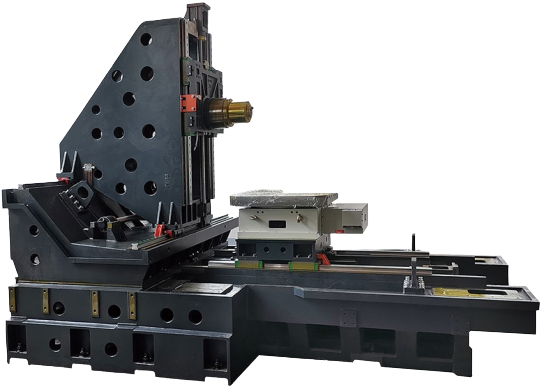 |
Machine Bed, Column Equilateral triangle structure of the column, multi-layer stiffeners are arranged to improve the stability of the machine bed. Positive T structure bed, X-axis stepped layout, enlarged line guideway span, rigid support. Adopt a high-strength Rexroth roller guide, high load bearing, and stable precision. |
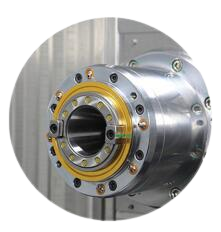 |
Spindle install 6 high-rigidity bearings; Outer diameter 190mm Taiwan original BBT50 spindle; Spindle air blow to prevent objects from entering the spindle; The spindle is equipped with ring spray to improve processing quality. The standard FANUC large-torque-wide-area motor ilP30/8000 is equipped with stronger heavy-cutting ability. |
 |
Optical Linear Scales Optional Heidenhain, Fagor Optical Linear Scales, accuracy ± 5um, to ensure machine tool positioning accuracy. |
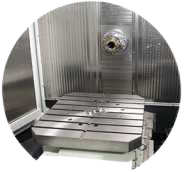 |
Double exchange table/ four-axis turntable Realize workpiece exchange and improve processing efficiency; The workpiece is placed outside for easy clamping; High rigidity alloy turbine, wear-resistant, high positioning accuracy; Heavy locking, reduces deformation, resistant to heavy cutting. |
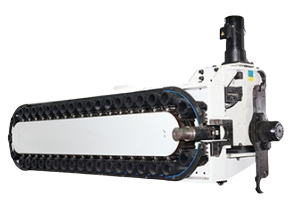 |
Tool magazine Using Taiwan imported frequency conversion tool magazine, tool change speed is fast and stable. |
The heart of a horizontal milling machine's functionality lies in its working principle, a blend of physics and mathematics that underpins the transformation of raw materials into precision-engineered parts.
In its simplest form, the operation of a horizontal milling machine involves the spindle's rotation, driving the cutter to chip away at the workpiece, which is steadily moved by the table. The energy from the motor converts into the rotational energy of the spindle, which, when transferred to the cutter, becomes the kinetic energy that helps remove material from the workpiece.
The sophistication of this process is amplified when we introduce mathematical models into the mix. The cutting speed (v), feed rate (f), and depth of cut (a) aren't chosen haphazardly; they are the result of careful calculations designed to optimize the machining process.
Cutting speed (v), given by the equation v = πDN, where D is the diameter of the cutter and N is the spindle's rotational speed, depends largely on the workpiece and cutter material. A higher cutting speed can lead to faster material removal, but must be carefully controlled to prevent excessive heat generation.
The feed rate (f), defined as the speed at which the workpiece is fed to the cutter, directly impacts the machining time and the surface finish. The choice of feed rate is crucial; it must ensure efficient machining without compromising the machine's or cutter's lifespan.
Lastly, the depth of cut (a) determines the amount of material removed in each pass. A deeper cut could speed up the machining process, but it also exerts more stress on the machine and could lead to a rougher finish.
These three parameters cutting speed, feed rate, and depth of cut form the triad of variables that dictate the effectiveness and efficiency of a horizontal milling machine's operation. By tweaking these variables using mathematical models, we can coax the machine into delivering the best possible performance. With this understanding, let's proceed to scrutinize the operations of these machines through a quantitative lens.
Stepping into the realm of quantitative analysis, we move from the theory of horizontal milling machine operation to the realities of cost, time, and optimization in real-world scenarios.
Horizontal milling machines carry out a plethora of operations, each one an orchestrated interplay of spindle speed, cutter movement, and table positioning. For instance, consider plane milling, where the cutter removes material along a flat plane of the workpiece. Or let's take a more complex operation like form milling, which creates contoured surfaces on the workpiece.

Each operation can be quantified in terms of time and cost. Let's take the example of a local automotive shop that uses a horizontal milling machine to shape engine components. If the shop rates are $100 per hour, and a plane milling operation on an aluminium block takes 30 minutes, the direct cost of operation is $50. However, if by optimizing feed rate, the operation time can be reduced to 20 minutes, the cost would drop to around $33, a significant reduction.
The key to such optimizations lies in the mathematical models discussed earlier. By accurately determining the optimal cutting speed, feed rate, and depth of cut, we can not only save time and reduce cost, but also extend the life of the cutter and maintain the quality of the finished product.
However, one must remember that every material and operation is unique. Therefore, the optimal parameters for one operation might not apply to another. So, the success of each operation hinges on the careful consideration of these factors, applying the mathematical models precisely and adjusting them as per the specific requirements. With this blend of theoretical models and practical applications, the world of horizontal milling machines truly comes to life.
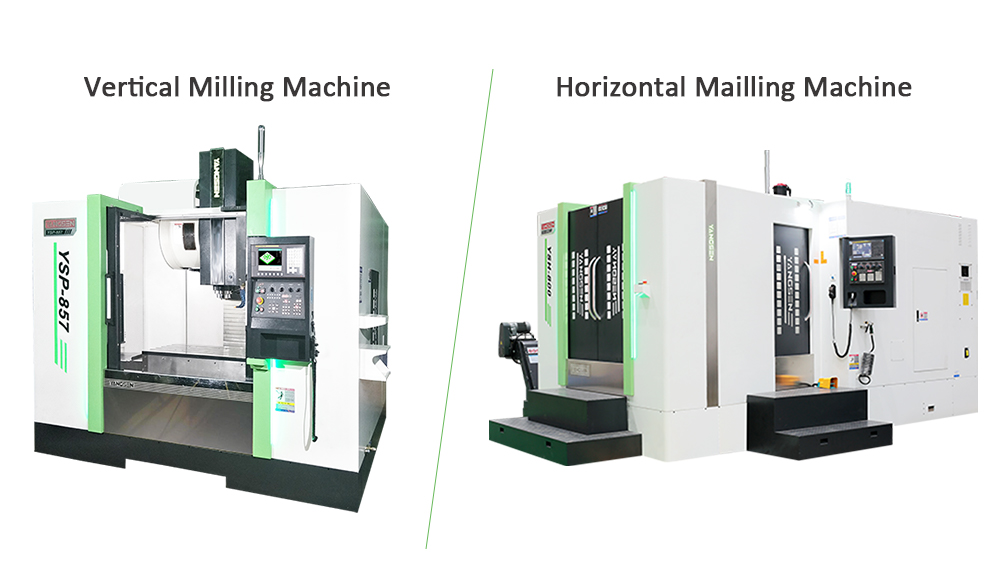
As we traverse the world of milling machines, a pertinent question often arises - which is more efficient, horizontal or vertical milling machines? To navigate this question, we must delve into a comparative analysis, supported by empirical data and real-world case studies.
At the outset, it's essential to understand that horizontal and vertical milling machines are tools with unique strengths, each better suited to certain tasks. Horizontal milling machines, with their ability to perform heavy-duty operations, are often the champions of efficiency when it comes to large-scale, high-volume tasks. Their design facilitates chip evacuation and allows for larger, more robust cutters, increasing the rate of material removal.
For instance, consider the case of a manufacturing firm that switched from vertical to horizontal milling for a high-volume order of a large, flat part. Post-switch, the operation's time was cut down by 40%, translating into substantial cost and time savings.
However, vertical milling machines are often the go-to option for complex shapes and smaller parts. Their design lends itself to detailed work, and the ability to move the cutter vertically provides additional flexibility. A case in point is a jewelry maker who uses a vertical mill to create intricate designs - a task where a horizontal mill would be less efficient.
Choosing between horizontal and vertical milling often boils down to the specific requirements of the job at hand. Factors like the complexity of the part, the volume of production, and the material can influence this decision. Theoretical considerations such as these, coupled with empirical data, allow for informed choices, ensuring that the milling machine chosen aligns well with the task, thus optimizing efficiency.
In conclusion, both horizontal and vertical milling machines have their own spheres of efficiency. It's not so much about which is universally better, but more about which is better suited to a specific job.
Safety and maintenance are two vital aspects of operating horizontal milling machines. Adherence to safety protocols and regular maintenance can prevent costly accidents and downtime, ensuring efficiency and productivity.
Operating a horizontal milling machine necessitates stringent safety precautions. From wearing appropriate personal protective equipment like safety glasses and gloves, to ensuring the workpiece is securely clamped, safety practices are integral to the milling process. Neglecting these measures can lead to accidents, resulting in injuries, equipment damage, and costly downtime. For instance, a momentary lapse in safety protocol that results in a shattered cutter could cost a company several hundred dollars in replacement parts and lost productivity.

Maintenance, too, is a critical part of the machine's lifecycle. Regular inspections and preventive maintenance can pre-empt issues, reducing repair costs and machine downtime. A well-planned maintenance schedule that includes cleaning, lubrication, and checking of parts, can extend the machine's life and optimize its performance. The cost of preventive maintenance, while seeming an immediate expenditure, pays off in the long run by minimizing the risk of major breakdowns. For instance, a monthly maintenance plan might cost a few hundred dollars, but it could prevent a catastrophic failure that could cost thousands in repairs and lost production.
Thus, safety measures and regular maintenance are not just ethical and practical requirements, but also smart economic decisions. These practices help to ensure the ongoing performance of the horizontal milling machine, securing both the operator's safety and the machine's productivity.
As we approach the frontier of technological advancements in milling, we find that the landscape is evolving rapidly, reshaping the efficiency and accuracy of milling operations. Central to this evolution is the advent of Computer Numerical Control (CNC) horizontal milling machines.
CNC technology has imbued horizontal milling machines with increased precision and automation. With the ability to follow computer-generated designs, CNC horizontal mills can execute complex operations with minimal human intervention. This results in significant time savings, lower labor costs, and a drastic reduction in human error.
A case in point is a manufacturing firm that transitioned to CNC milling and experienced a 25% increase in production efficiency, coupled with a 15% reduction in scrap due to fewer operator errors.
However, the march of technology doesn't stop here. The future of milling appears to be marked by trends such as multi-axis machining and increased automation. Multi-axis machines, capable of moving workpieces along multiple axes, promise to deliver even higher levels of precision and flexibility.
Meanwhile, further automation could streamline the milling process, reducing the need for manual intervention and further bolstering productivity. Integration of Artificial Intelligence (AI) could take this a step further, potentially enabling machines to learn from past operations, predict optimal machining parameters, and make real-time adjustments.
While it is challenging to precisely forecast the impact of these technologies, industry predictions suggest a potential increase in productivity of up to 30% over the next decade. This estimate stems from projected improvements in machine speed, reduction in manual input, and enhanced accuracy from AI-assisted operations.
The dawn of CNC technology and the tantalizing possibilities of future innovations illuminate a path towards unprecedented efficiency and accuracy in milling. As we step into this future, it is clear that the potential of horizontal milling machines is poised to reach new heights.
As we conclude this journey through the world of horizontal milling machines, their importance in today's industrial landscape stands unequivocally established. From dissecting their components to delving into the science behind their operation, we have quantified their efficiency, underscored by the palpable impact on time and cost.
As technology continues its relentless march, horizontal milling machines are becoming ever more precise, efficient, and autonomous. This evolution, encapsulated in the rise of CNC and the promising future of AI and automation, presents thrilling opportunities for further exploration and learning.
In a world that values precision, speed, and efficiency, the contribution of horizontal milling machines is paramount. As we continue to innovate, these machines will undoubtedly remain at the heart of modern manufacturing, driving our industries and economies forward.